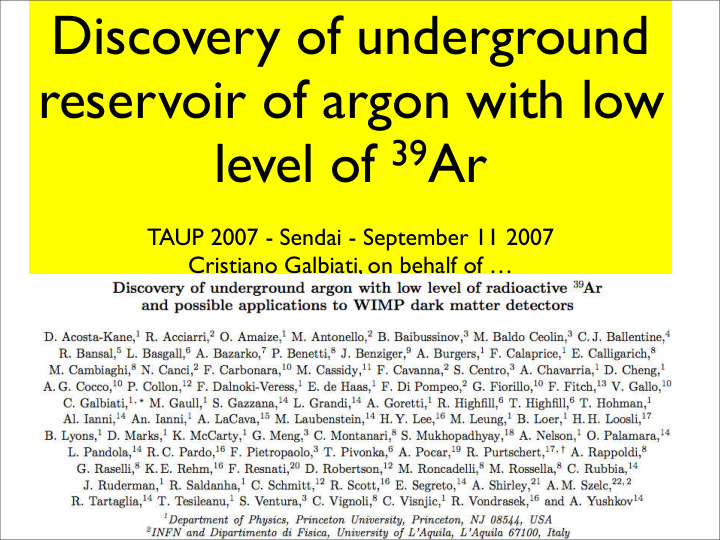



Discovery of underground reservoir of argon with low level of 39 Ar TAUP 2007 - Sendai - September 11 2007 Cristiano Galbiati, on behalf of …
Outline • Part of research program funded by NSF • Motivation for exploration of underground argon • Status and development of analytical techniques • Sample collection and preparation • Discovery of first source with low level of 39 Ar • Next step: massive collection of low background argon for large WIMP detector
Argon as target for WIMP detection • Liquid argon excellent material for WIMP and neutrino detection: • Copious scintillation • Excellent target for ionization detector • Best beta/recoil discrimination among energy-sensitive detectors. See next slide with last WARP records • Large-scale argon WIMP detectors under development • WARP 3.2-kg delivered first Ar-limit on WIMP detection (2006) • WARP 140-kg operating next year at LNGS
Recent WARP Results on Discrimination After recent electronics upgrade, pulse shape discrimination between m.i.p. and nuclear recoils better than 3x10 -7 for > 35 photoelectrons, better than 10 8 for > 50 photoelectrons Shape of distribution does not change by applying S2/S1 cut (reduction 5x10 2 ). Two discriminations independent within statistics collected.
Why is underground argon desirable? • Radioactive 39 Ar produced by cosmic rays in atmosphere • decays betas, Q = 565 keV, t 1/2 = 269 years • In atmospheric argon: • 39 Ar/Ar ratio 8 × 10 -16 • specific activity 1 Bq/kq • Limits size and sensitivity of argon detectors
Why is underground argon desirable? • 39 Ar-depleted argon available via centrifugation or thermal diffusion, but expensive at the ton scale! • 39 Ar production by cosmic rays strongly suppressed underground • Shielding of hydrocarbons in deep underground reservoirs results in low cosmogenic 14 C, important for solar neutrino detection • Borexino just reported measurement of solar 7 Be neutrinos • Background from 14 C defeated through use of scintillator from petrochemicals • In petrochemicals 14 C/C~10 -18 , six orders of magnitude lower than in atmospheric carbon ( 14 C/C~10 -12 )
Necessary to pre-scan sources of interest for 39 Ar • 39 Ar also produced underground by neutron activation, from fission and ( α ,n) neutrons • 39 K(n,p) 39 Ar • 39 Ar content depends on local content of U, Th, and K, and on rock porosity • In some groundwater samples 39 Ar/Ar ratio measured up to a factor 20 × (2000%) of the atmospheric ratio • Cannot rely on 39 Ar simply being low. Pre-scan of 39 Ar activity on small samples necessary for program.
Analytical techniques to measure 39 Ar • Three main techniques: • Counting of argon gas in low-background proportional detectors • Accelerator Mass Spectrometry (AMS) • Counting of argon in low-background liquid-phase detectors
Counting of argon gas in low- background proportional counters • First established (Loosli 1969) and still today standard method for 39 Ar determination • Collaborators Loosli and Purtschert run in Bern underground Lab dedicated facility for 39 Ar measurements since 1969 • Small samples (1-2 liters STP) of argon and limited depth (100 m.w.e.) required to measure 39 Ar at or below atmospheric level • 39 Ar sensitivity limited by detector background. Detector background must be carefully characterized by measurement with reference argon gas depleted in 39 Ar • Current limit on sensitivity at 5% of atmospheric level
Accelerator Mass Spectrometry (AMS) • Requires special Electron Cyclotron Resonance (ECR) ion source to create positive ions in multiple (7+,8+) ionization states • Combination of ECR source and ATLAS linear accelerator unique facility at Argonne National Labs • In 2002 campaign, reached a sensitivity for 39 Ar/Ar equivalent to 5% of atmospheric level • Most flexible tool: measurement requires few ml of STP argon
ATLAS at Argonne National Labs ECR Ion ATLAS Linear Spectrograph Source Accelerator
AMS: 2002 Test 39 Ar-spiked argon Deep ocean argon at 3000% of atm. activity at 30% of atm. activity Sensitivity limited by presence of 39 K background from ion source walls, intrinsic to aluminum
AMS: 2007 Test • 1 week run in June 2007, ECR source upgraded with addition of high purity aluminum liner • Reduction of K background by factor 13 • Sensitivity potentially increased to 0.5% of atmospheric level • Next step: • request of additional 2 weeks of time • measurement of large pool of samples at 0.5% atm. level
Counting in Liquid-phase detectors • WARP 3.2-kg reached accuracy of 10% of atmospheric level • Specially designed low background detector with 10-kg mass could reach below 0.1% of atmospheric level • Requires first large batch of argon from underground reservoir
Sample Preparation • Challenge: Ar in subsurface gases typically at few hundred ppm concentration. Needs large quantities with purity >50% • 1+yr R&D program in Princeton run by graduate student Ben Loer, senior Daniel Marks, freshman Daniel Acosta-Kane • Resulted in construction of two stages separation plant, deployable on the field • Chromatographic plant removes strongly adsorbing components (methane, ethane, heavy hydrocarbons, nitrogen, carbon dioxyde) • Cold trap removes helium, hydrogen • Achieves production of argon samples with purity exceeding 80%
Discovery of low 39 Ar from underground reservoirs Count Rate [µBq] Underground Ar 2036±43 39 Ar-Depleted Reference 2035±49 3625±77 Atmospheric Ar 1±65 (Under. Ar) - (Ref.) (Atm. Ar) - (Ref.) 1589±91 ( 39 Ar/Ar) und /( 39 Ar/Ar) atm 0.00 ±0.05 Submitted to Phys. Rev. Lett. Aug 30 2007
Conclusions • Discovery of underground reservoir with argon low in radioactive 39 Ar! Depletion factor at least 20 relative to atmospheric argon. • No 39 Ar detection, represents only upper limit. Motivates development of new, more sensitive techniques • Reservoir able to supply argon target for multi-ton WIMP/neutrino detector. • Collaboration developing with industry infrastructure for massive collection and underground storage of depleted argon
WARP Update Cryostat for 140-kg detector in Hall B, assembly started Operating 2008
Recommend
More recommend